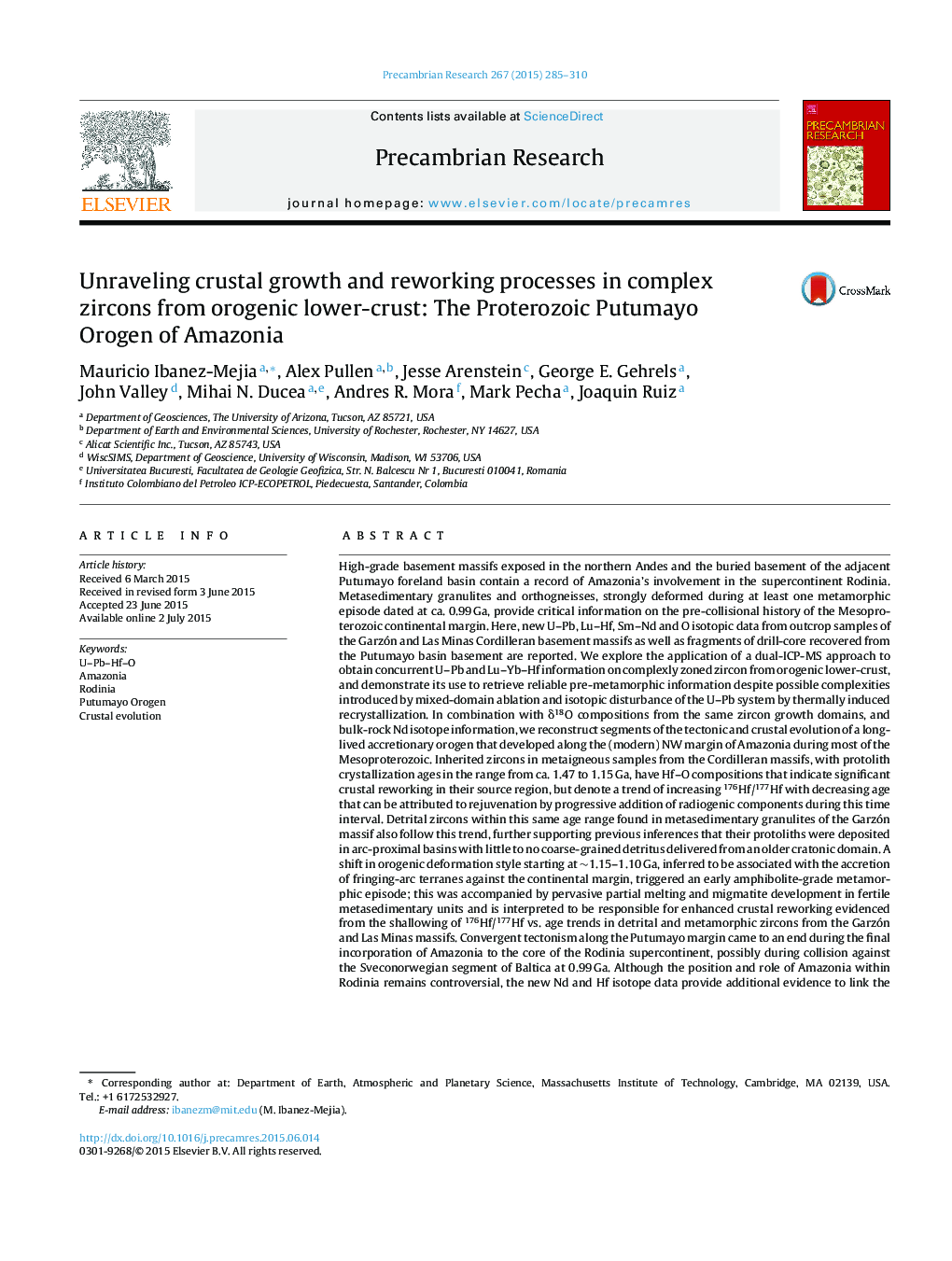| کد مقاله | کد نشریه | سال انتشار | مقاله انگلیسی | نسخه تمام متن |
|---|---|---|---|---|
| 4722619 | 1639608 | 2015 | 26 صفحه PDF | دانلود رایگان |
• We report new U–Pb, Lu–Hf, Sm–Nd and O isotopic data for the Putumayo Orogen of Amazonia.
• A long-lived Mesoproterozoic accretionary margin preceded Stenian–Tonian collision.
• Paleogeographic connections between NW Amazonia, the Andean massifs and Oaxaquia are reinforced.
• An approach for the simultaneous analysis of U–Pb and Yb–Lu–Hf is described.
High-grade basement massifs exposed in the northern Andes and the buried basement of the adjacent Putumayo foreland basin contain a record of Amazonia's involvement in the supercontinent Rodinia. Metasedimentary granulites and orthogneisses, strongly deformed during at least one metamorphic episode dated at ca. 0.99 Ga, provide critical information on the pre-collisional history of the Mesoproterozoic continental margin. Here, new U–Pb, Lu–Hf, Sm–Nd and O isotopic data from outcrop samples of the Garzón and Las Minas Cordilleran basement massifs as well as fragments of drill-core recovered from the Putumayo basin basement are reported. We explore the application of a dual-ICP-MS approach to obtain concurrent U–Pb and Lu–Yb–Hf information on complexly zoned zircon from orogenic lower-crust, and demonstrate its use to retrieve reliable pre-metamorphic information despite possible complexities introduced by mixed-domain ablation and isotopic disturbance of the U–Pb system by thermally induced recrystallization. In combination with δ18O compositions from the same zircon growth domains, and bulk-rock Nd isotope information, we reconstruct segments of the tectonic and crustal evolution of a long-lived accretionary orogen that developed along the (modern) NW margin of Amazonia during most of the Mesoproterozoic. Inherited zircons in metaigneous samples from the Cordilleran massifs, with protolith crystallization ages in the range from ca. 1.47 to 1.15 Ga, have Hf–O compositions that indicate significant crustal reworking in their source region, but denote a trend of increasing 176Hf/177Hf with decreasing age that can be attributed to rejuvenation by progressive addition of radiogenic components during this time interval. Detrital zircons within this same age range found in metasedimentary granulites of the Garzón massif also follow this trend, further supporting previous inferences that their protoliths were deposited in arc-proximal basins with little to no coarse-grained detritus delivered from an older cratonic domain. A shift in orogenic deformation style starting at ∼1.15–1.10 Ga, inferred to be associated with the accretion of fringing-arc terranes against the continental margin, triggered an early amphibolite-grade metamorphic episode; this was accompanied by pervasive partial melting and migmatite development in fertile metasedimentary units and is interpreted to be responsible for enhanced crustal reworking evidenced from the shallowing of 176Hf/177Hf vs. age trends in detrital and metamorphic zircons from the Garzón and Las Minas massifs. Convergent tectonism along the Putumayo margin came to an end during the final incorporation of Amazonia to the core of the Rodinia supercontinent, possibly during collision against the Sveconorwegian segment of Baltica at 0.99 Ga. Although the position and role of Amazonia within Rodinia remains controversial, the new Nd and Hf isotope data provide additional evidence to link the evolution of this orogenic segment with the basement of Oaxaquia, as well as continue to draw fundamental differences with the timing and nature of the tectonic processes associated with the development of the Sunsás-Aguapeí Orogen of SW Amazonia.
Journal: Precambrian Research - Volume 267, September 2015, Pages 285–310
